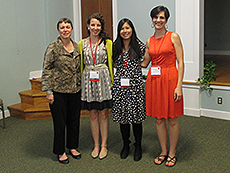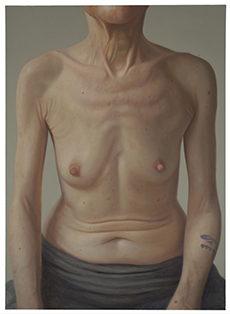Chelsea Woodard (Featured Poet)
Female Collector
Story hoarder, keeper of notes folded
in Latin class, stubs of dulled drawing pencils,
bits of wool sheared from the neighbor's ewe
(dyed pink or glossy white, like pearls),
drawers full of music boxes, the petty feuds of girls
(detailed in journals: grade 2, grade 9), coins
unearthed from extinction: Swiss francs, lire.
An entire life is possible to fold
away. The adolescent faces of girls
you grew up with: round, blonde-framed, penciled
in a litany of proms and first dates, adorned with pearls
worn by mothers and grandmothers. This older you
savors the dusty film forcing a U-
turn back to that time abroad, Cyrillic alphabets and rubles
pocketed as proof you watched the Neva purl
against its banks, that you never folded
your hand when it came to risk. The future pencils
in a calendar filled with the birthdays of girls
now in their thirties, swaddling baby girls
who stare from photographs, their wide eyes trying to figure you.
So many dried tubes of paint, so many saved pencils—
graphite and charcoal, white. They are precious as coins.
Here is a cigar box of shells; here is a flag folded
by somebody. Three separate sets of heirloom pearls.
The needles your mother used to teach you purl
one—all those uneven stitches a girl
has to learn. Bright colored paper folded
into origami cranes; the names of those you
once loved creased, faded by time, marked
by post stamp, scribbled in archival pencil.
The vision locks on a self-portrait drawn in pencil,
your own eyes bodiless, black-centered pearls
that swim up through the dark like krugerrands
sunk in a shipwreck. This is the record of a girl's
lost treasure, long stowed and loaded onto U-
Hauls, settled in closets, shelved and refolded
every time she's had to fold. Now the rain pounds
luminous pearls on the glass; now another you
smudges the pencil features of the girl.
Portrait of the Collector as a Young Man
I can scarcely manage to scribble a tolerable English letter.
I know that I am not a scholar, but meantime I am aware
that no man living knows better than I do the habits of our birds.
—John James Audubon
When I came to the woods, I knew the ferns
were full of longing. Far from the bells
and white-fenced greens of towns, I have learned
the pardon of mosses, taking up spent shells
that glitter on the shade-dark earth like gold
fillings. Weightless as a carcass
free of flesh, my pack holds
spare instruments: a compass
and charcoal sticks, oil pigments, brushes.
My gun is a light, cold metal rasping
in its leather sleeve. Parting bulrushes
encircling a pond, I gasp
as a bittern lifts, ruffles the surface and squawks
toward the tree line. The bones
of a loon are hollow; no body that walks
can know what it is to skim alone
the tops of hemlocks, to see the sun rise
from a nest of dry branches afloat
in a pine. I wake to the eaglets' cries,
study my sketches, letters I wrote
home to Lucy. What brought me to this place
was not their plumage, alizarin
and umber, nor a man's arrogant race
against where time will drive him—
no. It was the patterns of their flight—
great swooping arcs, marvelous shapes that glide
and shrink to black. The canvas's white
expanse is where their glory hides.
And so I've reimagined all the birds
as silent, stationary things
that cannot render viewers wordless
at the rustle of their wings.
Krugerrands
for B.
Buried just behind the granite post
that marks the outline of my garden, the gold
grows colder. Its presence is my family's lore,
and like most myths, it seems fantastic, old;
some muggy August days it is a sore
that festers in the earth, or else it is a ghost
entombed below my heart—hepatic, dark.
All that the gate of love let in I've tried
to stone out—restoring toppled walls that littered
my pastures with feldspar and quartz—lost
fortunes. Blinded by bullion glitter,
we were naïve to what our secret cost,
and let the myrtle grow. Its rich leaves lied.
I can still see the heaving shovel's mark.
Tower
In the Minchiate tarot deck, this card depicts two
naked figures fleeing from a burning structure.
Running through the granite door,
we never turned to see the great room
burning. Our feet had callouses of char; the air
held the smell of singed hair—
your green eyes lashless, your forearms bare.
But the hillsides were still brimming spring.
Our smoke-clogged bodies bled black riverbeds
of stones, smooth and cool in a bather's fingers.
The fire has left a ring
of ashes on the grass. Lately, I sing
to hear the heaviness of sound
falling, to watch its fullness swell
and drop like rain. Your anger is like rain
that gathers around
the parched flowers, and mine is the ground.
Nostalgia
At seven the sadness was grave, like a dove
in spring half-dark wringing
the light from it. I had known little
of real grief—having been allowed
lazy stretches of aimlessness, love,
a slow buzzing passage of stings
from sharp grasses and bees—the grim rattle
held off by a riot of wildflowers
drowning its song. It began as an art
for remembering: larch needles
and doll clothes, a wing from a moth—a pattern
unbreakable now, held still in the mouths
of propped windows. Curtains part.
In the road, a girl pedals
home, and the low metal creak of the lantern
is blooming I can't get out.
Freeze Line
The angling settlement has been shut up
for months, and all this time we've shuffled
timidly on shifting ice, watching
the sky, the porch thermometer, missing
the dry wood creak of dory oars, the sun.
Anxious for spring, we saw the thawing balsams
as a sign we had come through, wintered this last,
cold-growing sorrow. Today we coast out
to the mouth of the river, past the eagle's nest
and pools broken by deadheads, where the silt sets
rust-like on the banks and the lake rests, washes
over algae-slick rocks. I watch
the wheel rasp under your palms, knowing you watch
for rocks, shallow spots, the darker patches
showing wind—warnings that have been passed
down over a lifetime. Fly rods catch dust
on the camp rafters. Soon, fishermen
will come back to these waters; fathers will show
their sons to tie flies, to cast out toward the drowned
line of trunks, where branches stop, where ice swells the banks
and the cold writes its name on the land.
The Bat
Downstairs, above my writing desk, her body
flitted overhead without my knowing—
something moth-like, a momentary shadow
on the ceiling light, a breath. It took
six passes for her presence to take shape,
for me to look from where I bent to see
the furry underside, her brown wings beating,
silent, in this strange, narrow enclosure,
brushing neither the window nor the wall,
calm almost, as if she trusted something in kind
in here would free her, heard long before I opened
it the sudden door leading her back into the dark.
|
|
 |
 |
|
|
 |
 |
Jenna Le, Anne-Marie Thompson, and Chelsea Woodard join editor Kim Bridgford at the tenth-anniversary Mezzo Cammin panel at the Poetry by the Sea conference.
Sophia Galifianakis was the recipient of the Mezzo Cammin scholarship.
|
|
|
 |
|
|
|
 |
Corpus VI was formed in 2003, when six women figurative painters, who studied together at the Pennsylvania Academy of the Fine Arts, united to curate, exhibit and present our work to the public on our own terms, and launch our artistic careers. The name was chosen because it reflected our shared commitment to figurative representation. Clarity Haynes, Elena Peteva, and Suzanne Schireson were three of the founding members of the group, which organized an inaugural, self-titled show at Philadelphia's Highwire Gallery in the spring of 2005. The exhibition essay was written by Jeffrey Carr, Dean of the Pennsylvania Academy of the Fine Arts. The exhibition was very well-attended and reviewed in several art publications.
The experience of working together to successfully realize this exhibition, as well as the continuous dialogue and exchange of ideas on contemporary figuration, has proven to be greatly valuable to us. Ten years after graduating from PAFA, as our careers have taken us to different locations across the United States, three of the original members, Clarity Haynes, Suzanne Schireson, and Elena Peteva, have come together to reinvent the collective by inviting one artist each to be part of this exhibition that will begin at the New Bedford Art Museum in fall 2015 and travel to other institutions.
Holly Trostle Brigham, Stacy Latt Savage and Laurie Kaplowitz are professional figurative artists, whose strong artistic visions enrich the collective's range and explorations of contemporary representation. We are excited at the prospect of seeing our work all together in new configurations, creating new dialogues. Holly Brigham creates imaginative, narrative watercolors, which tell a feminist story, inserting her artistic persona into art historical narratives and mythologies. Laurie Kaplowitz uses textured paint to create personages that hint at the soul within, alluding to rituals of marking, scarring and adorning the body as an integral part of our human identity and presentation. Stacy Latt Savage combines figurative elements with fabricated structures and shapes to create objects that capture what it looks like to feel human and the complexities of our human condition. Clarity Haynes casts new light on ideas of beauty, femininity and embodiment through her realistic painted portraits of the female torso. Elena Peteva creates allegorical representations of our individual and social states through the human figure and subtle, charged, incomplete signs that invite the viewer's attempt for interpretation. Suzanne Schireson is influenced by her great-grandfather's autobiography as an early plastic surgeon and her paintings examine contradictions surrounding the birth of cosmetic surgery, such as the power to heal and the fostering of insecurity.
|
|
|
|
|
|
 |
|
 |
|
|
|
|
